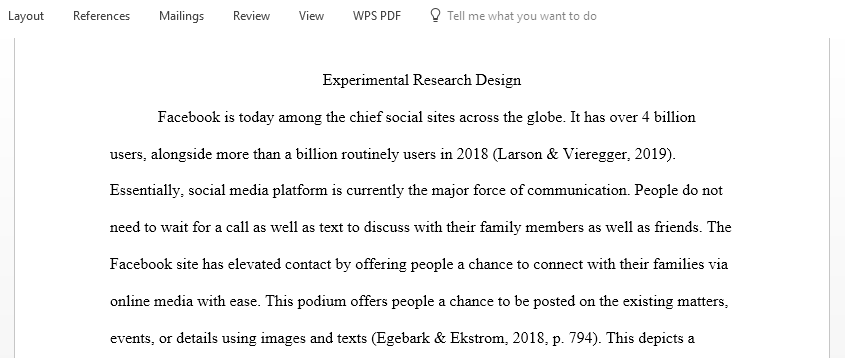Discuss Facebook Experimental Research Design
Discuss Facebook Experimental Research Design. The final type of research you will discuss is experimental research. Experimentation is conducted in order to test a causal hypothesis. That is, you want to determine if an independent variable (X) caused a dependent variable (Y). In order to do so, you have to show that X precedes Y, which the two variables are associated, and you need to eliminate other possible causes of the change in Y. In an experiment, a researcher manipulates the independent variable and measures its impact on the dependent variable while at the same time controlling for all other variables that may have influenced the dependent variable. Their other variables are referred to as extraneous or potentially confounding variables (e.g., if you wanted to determine if gender had an influence on the perceived trustworthiness of a spokesperson in an advertisement). Using this example, a researcher could create two mock ads that are designed to be exactly the same except for the gender of the spokesperson.
When designing an experiment, the researcher wants to determine:
(1) whether the independent variable is the sole cause of any change in the dependent variable; and
(2) if the results of the experiment can be generalized to other populations, settings, times, etc. These are referred to as internal and external validity.
In order to show that the independent variable (X) is the sole cause of any change in the dependent variable (Y), three pieces of evidence are needed. For X to be a cause of Y, X must precede Y in time. In addition, X and Y must vary together. And finally, for X to be a cause of Y, other possible causes of Y, alternative explanations, must be eliminated. These alternative explanations are referred to as an extraneous variable
or potentially confounding variables.
In contrast to internal validity, external validity refers to the generalizability of the study results. For instance, with respect to generalizing to the population, you would have better external validity if the sample was taken randomly from the population. This would have no impact on internal validity, however.
Note that there is often a tradeoff between internal and external validity and the experimental setting (a lab vs. field experiment). A laboratory experiment is an artificial setting that allows the researcher better control over extraneous/potentially confounding variables. However, the artificiality of a lab experiment tends to lessen the external validity since you want to be able to generalize to a more realistic setting. Essentially laboratory vs. field experiments represents opposite ends of a continuum having to do with the artificiality of the setting.
Be sure to review this week’s resources carefully. You are expected to apply the information from these resources when you prepare your assignments.
Answer preview for Discuss Facebook Experimental Research Design

Access the full answer containing 1765 words by clicking the below purchase button
